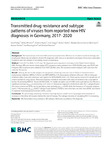2023-10-10Zeitschriftenartikel
Transmitted drug resistance and subtype patterns of viruses from reported new HIV diagnoses in Germany, 2017–2020
Fiebig, Uwe
Altmann, Britta
Koppe, Uwe
Hanke, Kirsten
Gunsenheimer-Bartmeyer, Barbara
Bremer, Viviane
Baumgarten, Axel
Bannert, Norbert
Background The transmission of resistant HIV variants jeopardizes the effective use of antiretrovirals for therapy and
prophylaxis. Molecular surveillance of new HIV diagnoses with a focus on prevalence and type of resistance associated
mutations and the subtype of circulating viruses is mandatory.
Method From 2017 to 2020, 11,527 new HIV diagnoses were reported in Germany to the Robert Koch Institute
(RKI). Protease (PR) and reverse-transcriptase (RT) sequences were obtained from 4559 (39.6%) cases, and PR, RT and
integrase (IN) sequences were obtained from 3097 (26.9%) cases. The sequences were analyzed with data from the
national HIV reports.
Results Among all cases in the analysis, the proportion of primary resistance was 4.3% for nucleoside reverse-
transcriptase inhibitors (NRTIs), 9.2% for non-NRTI (NNRTIs), 3.3% for protease inhibitors (PIs) and 1.4% for integrase
inhibitors (INIs). Dual-class resistance was highest for NRTIs/NNRTIs with 1.2%. There was no trend in the proportion of
viruses resistant to drug classes. Most individual key mutations associated with relevant resistance had a prevalence
below 1% including K65R (0.1%) and M184V (0.6%). A notable exception was K103NS, with a prevalence of 2.9% and a
significant increase (pTrend=0.024) during 2017–2020. In this period, diagnoses of infections with HIV-1 subtype B were
the most common at 58.7%, but its prevalence was declining (pTrend=0.049) while the frequency of minority subtypes
(each < 1%) increased (pTrend=0.007). Subtype B was highest (75.6%) in men who have sex with men (MSM) and lowest
in reported heterosexual transmissions (HETs, 22.6%).
Conclusion The percentage of primary resistance was high but at a stable level. A genotypic determination of
resistance is therefore still required before the start of therapy. The subtype diversity of circulating HIV-1 is increasing.
Dateien zu dieser Publikation

